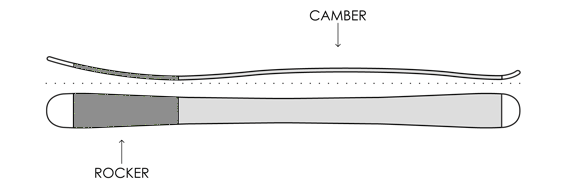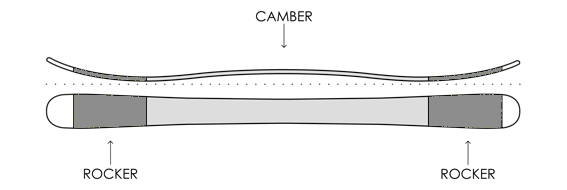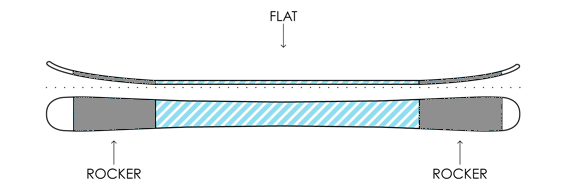Type of rocker
 TYPE OF ROCKER
TYPE OF ROCKER
The camber is the longitudinal shape that is given to the ski. Areas that are elevated above the snow are called Rocker.
TRADITIONAL CAMBER
When a traditional ski is placed on the ground, the contact points of the ski on the snow are located near the tip and tail, while the centre of the ski (under the bindings) lifts slightly.
This construction offers excellent precision with a lot of energy on groomed terrain and harder snow. High-level park skiers often prefer this camber.

100% ROCKER/TIPPER
The Rocker is a reverse camber. This type of rocker offers superior flotation in soft powder snow. On a ski with reverse camber or "rocker", the tip (but also the tail, depending on the shape) lifts off the ground much earlier than on a cambered ski, which moves the contact points towards the centre of the ski.
Rocker skis are easier to turn between turns and can be skied for slightly f longer than camber skis.

ROCKER IN SPATULA OR HEEL
A rocker in the tip of the ski will allow the ski to be lifted more easily in fresh snow and thus provide better flotation, while a rocker at the back of the ski allows better manoeuvrability in powder.
Scalable piste skis: a slight front rocker + a classic camber
All-mountain skis: 30% rocker + 70% classic camber

ROCKER/CAMBER/ROCKER
The Rocker/Camber/Rocker skis have the enjoyment and float of a rocker ski and the support of a cambered ski. The contact points on the skis with this profile are closer to the middle of the ski than a fully cambered ski. The cambered midsection provides a longer effective edge on the hardpack, increasing stability and edge hold, while the tipped tip and tail provide flotation in deeper snow. This profile offers an escape for park skiers, flotation for powder lovers, tolerance for beginners and versatility for those who only have one pair of skis.
Many ski manufacturers offer several types of "Rocker/Camber/Rocker" to accommodate different skiers, combining different amounts of rocker and camber with different ski widths and sidecuts.
Versatile freeride skis: 50% rocker + 50% classic camber

ROCKER/FLAT/ROCKER
The latter will have better behaviour in powder, but will sacrifice its ability to grip on hard snow since the contact surface with the snow is minimal. The ski pivots very easily around the skate for greater manoeuvrability, but this still takes some getting used to. The performance is between a fully balanced ski and a rocker/camber/rocker ski.

No one profile beats the other that matches your personal preferences.
As a general rule, the camber offers better handling and stability on the park and at high speeds, while the rocker offers more flotation in powder snow and a more forgiving ride. Advanced skiers who like strong sensations can also enjoy using rocker skis.
THE IMPORTANCE OF A ROCKER
A rocker offers increased flotation in powder snow!
The feeling is smooth and just like surfing, wakeboarding or waterskiing, the rocker helps you float and stay above the snow. On skis or on a board, your tip extends so you can avoid sticking it in the snow. On the skis, bouncing and cushioning are effortless. You can maintain a more balanced driving position that saves energy and improves your reaction time.
Easier to manoeuvre
The rocker lifts the heel and tip up and off the snow, shortening the contact length of the edges and making turns easier. Your walk becomes easier and more manageable, allowing you to pivot and "glide" easily. The increased mobility is ideal between trees and narrow paths.
Facilitates the practice of the park
The less attractive nature of a ski or snow rocker allows you to initiate your spins early and gives you a greater ability to recover from off-axis landings.
FOR WHOM?
Everyone can choose a ski or snowboard with a rocker and have fun. Beginner to expert, young or old, take advantage of rocker technology. Easier and more fun. Today, manufacturers such as Rossignol, K2, Burton and many others have developed so many combinations that you'll be sure to find one that suits you.
FOR WHAT?
You can practice all terrains and programmes, freeride, freestyle, powder, park and off-piste circuit, the rocker is not an obstacle.
However, avoid glaciers and rough off-piste terrain, as these areas require very specific boards adapted to this practice.
